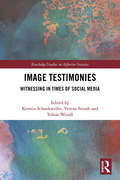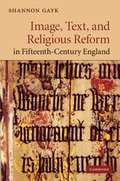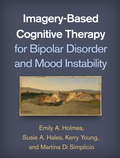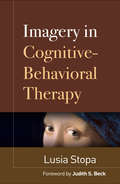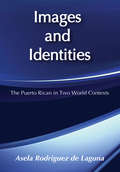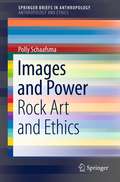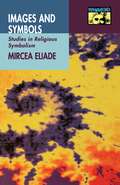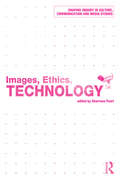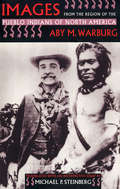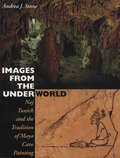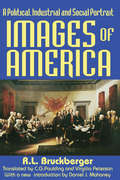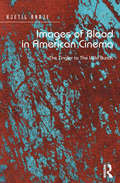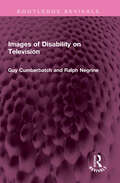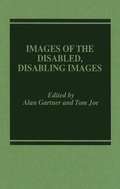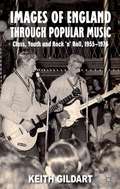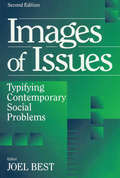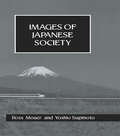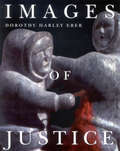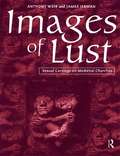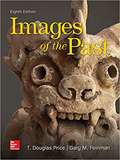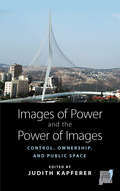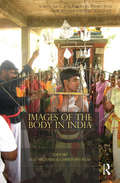- Table View
- List View
Image Testimonies: Witnessing in Times of Social Media (Routledge Studies in Affective Societies)
by Kerstin Schankweiler Verena Straub Tobias WendlRecent political conflicts signal an increased proliferation of image testimonies shared widely via social media. Although witnessing with and through images is not a phenomenon of the internet era, contemporary digital image practices and politics have significantly intensified the affective economies of image testimonies. This volume traces the contours of these conditions and develops a conception of image testimony along four areas of focus. The first and second section of this volume reflects the discussion of image testimonies as an interplay of evidential qualities and their potential to express affective relationalities and emotional involvement. The third section focuses on the question of how social media technologies shape and subsequently are shaped by image testimonies. To further complicate the ethical position of the witness, the final section looks at image testimony at the intersection of creation and destruction, taking into account the perspectives of different actors and their opposed moral positions. With an emphasis on the affectivity of these images, Image Testimonies provides new and so far overlooked insights in the field. It will appeal to students and researchers interested in fields such as Sociology and Social Policy, Media and Communications, Visual Arts and Culture and Middle East Studies.
Image, Text, and Religious Reform in Fifteenth-Century England
by Shannon GaykFocusing on the period between the Wycliffite critique of images and Reformation iconoclasm, Shannon Gayk investigates the sometimes complementary and sometimes fraught relationship between vernacular devotional writing and the religious image. She examines how a set of fifteenth-century writers, including Lollard authors, John Lydgate, Thomas Hoccleve, John Capgrave, and Reginald Pecock, translated complex clerical debates about the pedagogical and spiritual efficacy of images and texts into vernacular settings and literary forms. These authors found vernacular discourse to be a powerful medium for explaining and reforming contemporary understandings of visual experience. In its survey of the function of literary images and imagination, the epistemology of vision, the semiotics of idols, and the authority of written texts, this study reveals a fifteenth century that was as much an age of religious and literary exploration, experimentation, and reform as it was an age of regulation.
Imagery-Based Cognitive Therapy for Bipolar Disorder and Mood Instability
by Emily A. Holmes Susie A. Hales Kerry Young Martina Di SimplicioPeople with bipolar disorder are particularly vulnerable to anxiety and intrusive mental imagery, which can contribute to mood swings and a heightened risk for relapse. This book presents a novel brief treatment that focuses on working with mental images to reduce distress and enhance mood stability. Grounded in cognitive-behavioral therapy (CBT), the book provides therapists with tested techniques for formulating individualized treatment targets, using metacognitive strategies to reduce the power of images, rescripting problematic images, and building adaptive positive images. User-friendly instructions for assessment and intervention include case examples, sample scripts, and troubleshooting tips. In a large-size format for easy photocopying, the book includes 19 reproducible handouts and session agendas. Purchasers get access to a Web page where they can download and print the reproducible materials.
Imagery in Cognitive-Behavioral Therapy
by Lusia StopaRichly illustrated with clinical material, this book presents specific techniques for working with multisensory imagery in cognitive-behavioral therapy (CBT). Leading researcher-clinician Lusia Stopa explores how mental images--similarly to verbal cognitions--can trigger distress and drive maladaptive behavior. She guides the therapist to assess imagery and help clients to recognize and explore it. A range of interventions are described, including imaginal exposure, imaginal reliving, rescripting, working with self-images, and using positive imagery to improve well-being. Extensive sample dialogues and a chapter-length case example demonstrate the techniques in action with clients with a range of frequently encountered psychological problems.
Images and Identities: Puerto Rican in Two World Contexts
by Asela Rodriguez LagunaFirst published in 1987. Routledge is an imprint of Taylor & Francis.
Images and Power
by Polly SchaafsmaEthics and Rock Art: Images and Power addresses the distinctive ways in which ethical considerations pertain to rock art research within the larger context of the archaeological ethical debate. Marks on stone, with their social and religious implications, give rise to distinctive ethical concerns within the scholarly enterprise as different perceptions between scholars and Native Americans are encountered in regard to worldviews, concepts of space, time, and in the interpretation of the imagery itself. This discourse addresses issues such as the conflicting paradigms of oral traditions and archaeological veracity, differing ideas about landscapes in which rock art occurs, the intrusion of "desired knowledge", and how the past may be robbed by changing interpretations and values on both sides. Case studies are presented in regard to shamanism and war-related imagery. Also addressed are issues surrounding questions of art, aesthetics, and appropriation of imagery by outsiders. Overall, this discourse attempts to clarify points of contention between Euro-American scholars and Native Americans so that we can better recognize the origins of differences and thus promote better mutual understanding in these endeavors.
Images and Symbols: Studies in Religious Symbolism
by Mircea EliadeMircea Eliade--one of the most renowned expositors of the psychology of religion, mythology, and magic--shows that myth and symbol constitute a mode of thought that not only came before that of discursive and logical reasoning, but is still an essential function of human consciousness. He describes and analyzes some of the most powerful and ubiquitous symbols that have ruled the mythological thinking of East and West in many times and at many levels of cultural development.
Images and Symbols: Studies in Religious Symbolism (Bollingen Series #684)
by Mircea EliadeMircea Eliade--one of the most renowned expositors of the psychology of religion, mythology, and magic--shows that myth and symbol constitute a mode of thought that not only came before that of discursive and logical reasoning, but is still an essential function of human consciousness. He describes and analyzes some of the most powerful and ubiquitous symbols that have ruled the mythological thinking of East and West in many times and at many levels of cultural development.
Images, Ethics, Technology (Shaping Inquiry in Culture, Communication and Media Studies)
by Sharrona PearlImages, Ethics, Technology explores the changing ethical implications of images and the ways they are communicated and understood. It emphasises how images change not only through their modes of representation, but through our relationship to them. In order to understand images, we must understand how they are produced, communicated, and displayed. Each of the 14 essays chart the relationship to technology as part of a larger complex social and cultural matrix, highlighting how these relations constrain and enable notions of responsibility with respect to images and what they represent. They demonstrate that as technology develops and changes, the images themselves change, not just with respect to content, but in the very meanings and indices they produce. This is a collection that not only asks: who speaks for the art? But also: who speaks for the witnesses, the cameras, the documented, the landscape, the institutional platforms, the taboos, those wishing to be forgotten, those being seen and the experience of viewing itself? Images, Ethics, Technology is ideal for advanced level students and researchers in media and communications, visual culture and cultural studies.
Images from Paradise: The Visual Communication of the European Union's Federalist Utopia
by Eszter SalgóDrawing upon the disciplines of politics, anthropology, psychoanalysis, aesthetics and cinema studies, Salgó presents a new way of looking at the "art of European unification." The official visual narratives of the European Union constitute the main object of inquiry – the iconography of the new series of euro banknotes and the videos through which the supranational elite seek to generate "collective effervescence," allow for a European carnival to take place, and prompt citizens to pledge allegiance to the sacred dogma of the "ever closer union," thereby strengthening the mythical sources of the organization's legitimacy. The author seeks to illustrate how and why the federalist utopia turned into a political soteriology after the outbreak of the 2008 crisis.
Images from the Region of the Pueblo Indians of North America
by Aby M. WarburgAby M. Warburg (1866–1929) is recognized not only as one of the century’s preeminent art and Renaissance historians but also as a founder of twentieth-century methods in iconology and cultural studies in general. Warburg’s 1923 lecture, first published in German in 1988 and now available in the first complete English translation, offers at once a window on his career, a formative statement of his cultural history of modernity, and a document in the ethnography of the American Southwest. This edition includes thirty-nine photographs, many of them originally presented as slides with the speech, and a rich interpretive essay by the translator.
Images from the Underworld: Naj Tunich and the Tradition of Maya Cave Painting
by Andrea J. StoneThe present volume is not only an extraordinarily detailed and insightful analysis of the painted representations and texts found in Naj Tunich but also a complete survey of all known Maya painted caves. . . . Stone has given us a major monograph on a major Maya site. For completeness of presentation, for clarity of writing, and for depth and scope of analysis, it is a model of what a final report should be, but seldom is. -- Michael D. Coe, Journal of Anthropological Research In 1979, a Kekchi Maya Indian accidentally discovered the entrance to Naj Tunich, a deep cave in the Maya Mountains of El Peten, Guatemala. One of the world's few deep caves that contain rock art, Naj Tunich features figural images and hieroglyphic inscriptions that have helped to revolutionize our understanding of ancient Maya art and ritual. In this book, Andrea Stone takes a comprehensive look at Maya cave painting from Preconquest times to the Colonial period. After surveying Mesoamerican cave and rock painting sites and discussing all twenty-five known painted caves in the Maya area, she focuses extensively on Naj Tunich. Her text analyzes the images and inscriptions, while photographs and line drawings provide a complete visual catalog of the cave art, some of which has been subsequently destroyed by vandals. This important new body of images and texts enlarges our understanding of the Maya view of sacred landscape and the role of caves in ritual. It will be important reading for all students of the Maya, as well as for others interested in cave art and in human relationships with the natural environment. "
Images from the Underworld: Naj Tunich and the Tradition of Maya Cave Painting
by Andrea J. StoneAn in-depth look at Maya cave painting from Preconquest times to the Colonial period, plus a complete visual catalog of the cave art of Naj Tunich.In 1979, a Kekchi Maya Indian accidentally discovered the entrance to Naj Tunich, a deep cave in the Maya Mountains of El Peten, Guatemala. One of the world&’s few deep caves that contain rock art, Naj Tunich features figural images and hieroglyphic inscriptions that have helped to revolutionize our understanding of ancient Maya art and ritual.In this book, Andrea Stone takes a comprehensive look at Maya cave painting from Preconquest times to the Colonial period. After surveying Mesoamerican cave and rock painting sites and discussing all twenty-five known painted caves in the Maya area, she focuses extensively on Naj Tunich. Her text analyzes the images and inscriptions, while photographs and line drawings provide a complete visual catalog of the cave art, some of which has been subsequently destroyed by vandals.This important new body of images and texts enlarges our understanding of the Maya view of sacred landscape and the role of caves in ritual. It will be important reading for all students of the Maya, as well as for others interested in cave art and in human relationships with the natural environment.&“Not only an extraordinarily detailed and insightful analysis of the painted representations and texts found in Naj Tunich but also a complete survey of all known Maya painted caves. . . . A major monograph on a major Maya site. For completeness of presentation, for clarity of writing, and for depth and scope of analysis, [Images from the Underworld] is a model of what a final report should be.&” —Journal of Anthropological Research
Images of America: A Political, Industrial and Social Portrait
by R.L. Bruckberger"Either America is the hope of the world, or it is nothing. Th ere are those who have begun to despair of the West. It is for them that I am writing." Bruckberger's book has been compared by many to Tocqueville's Democracy in America. In both works, Americans see themselves through the sympathetic, sometimes critical eyes of a Frenchman. Bruckberger, as chaplain general of the French Resistance during World War II, was a scholar who lived a life of action, and a priest who knew the life of the spirit. He begins with a celebration of the American past, but also off ers a clear warning for the future.The book was written after Bruckberger's eight years in the United States, during which he thought deeply about the country, and came to love and admire it. He sees what others have not, and his heroes are, in most instances, not the ones normally chosen. As seen from the perspective of the old Europe, the ideas and ideals that have shaped the history and character of America, take on a new meaning. The result is an image of America that is as enlightening as it is surprising.Bruckberger believes America brings to the Western heritage an essential spark, one vital for the angry and perilous post-World War II world, and one equally important today. That is America's regard for the individual, for the non-abstract, living human being. This theme, contrasted with what Bruckberger sees as the heresy of Europe--the subordination of human beings to abstraction is developed with wit and insight.
Images of Blood in American Cinema: The Tingler to The Wild Bunch
by Kjetil RødjeThrough studying images of blood in film from the mid-1950s to the end of the 1960s, this path-breaking book explores how blood as an (audio)visual cinematic element went from predominately operating as a signifier, providing audiences with information about a film’s plot and characters, to increasingly operating in terms of affect, potentially evoking visceral and embodied responses in viewers. Using films such as The Return of Dracula, The Tingler, Blood Feast, Two Thousand Maniacs, Color Me Blood Red, Bonnie and Clyde, and The Wild Bunch, Rødje takes a novel approach to film history by following one (audio)visual element through an exploration that traverses established standards for film production and reception. This study does not heed distinctions regarding to genres (horror, western, gangster) or models of film production (exploitation, independent, studio productions) but rather maps the operations of cinematic images across marginal as well as more traditionally esteemed cinematic territories. The result is a book that rethinks and reassembles cinematic practices as well as aesthetics, and as such invites new ways to investigate how cinematic images enter relations with other images as well as with audiences.
Images of Disability on Television (Routledge Revivals)
by Guy Cumberbatch Ralph NegrineFirst published in 1992, Images of Disability on Television examines the frequency and nature of disability on British and American television and how it is perceived and presented by programme makers. Attitudes held by those closest to the issues – disabled people, their carers, and television producers and writers – are presented as the result of interviews and discussions. There is an increasingly strong sentiment that television has got it wrong as far as disability is concerned and does not play its proper role in allowing the non-disabled to understand fully the world of disabled people. This book provides information to promote greater understanding of the needs of the disabled people in television portrayal and opens up possibilities for a change in attitudes. It will be valuable reading for students, researchers and lecturers in the social sciences, communication studies, and media studies.
Images Of The Disabled, Disabling Images
by Alan Gartner Tom JoeThe first book of its kind, Images of the Disabled/Disabling Images combines an examination of the presentation of persons with disabilities in literature, film, and the media with an analysis of the ways in which these images are expressed in public policy concerning the disabled. <P><P> Leaders of the disability rights movement and major scholars of disability issues explore both attitudes toward the disabled, as well as the ways in which the disabling images of these attitudes are incorporated in employment, health, housing, and education policies. <P><P>Discussions include the appeal of new technological aids and new developments in community living. The first book of its kind, Images of the Disabled/Disabling Images combines an examination of the presentation of persons with disabilities in literature, film, and the media with an analysis of the ways in which these images are expressed in public policy concerning the disabled. Leaders of the disability rights movement and major scholars of disability issues explore both attitudes toward the disabled, as well as the ways in which the disabling images of these attitudes are incorporated in employment, health, housing, and education policies. Discussions include the appeal of new technological aids and new developments in community living.
Images of England Through Popular Music: Class, Youth and Rock 'n' Roll, 1955-1976
by Keith GildartDrawing on archival sources and oral testimony, Keith Gildart examines the ways in which popular music played an important role in reflecting and shaping social identities and working-class cultures and - through a focus on rock 'n' roll, rhythm & blues, punk, mod subculture, and glam rock - created a sense of crisis in English society.
Images of Issues: Typifying Contemporary Social Problems (Social Problems And Social Issues Ser.)
by Joel BestConstructionist theory describes and analyzes social problems as emerging through the efforts of claimsmakers who bring issues to public attention. By typifying a problem and characterizing it as a particular sort, claimsmakers can shape policymaking and public response to the problem. Th is new edition of Images of Issues addresses claimsmaking in the 1990s, featuring such issues as fathers' rights, stalking, sexual abuse by the clergy, hate crimes, multicultural education, factory farming, and concluding with an expanded discussion of the theoretical debate over constructionism.
Images Of Japanese Society Hb
by Ross Mouer Yoshio SugimotoThe popular image of Japanese society is a steroetypical one - that of a people characterised by a coherent set of thought and behaviour patterns, applying to all Japanese and transcending time. Ross Mouer and Yoshio Sugimoto found this image quite incongruous during their research for this book in Japan. They ask whether this steroetype of the Japanese is not only generated by foreigners but by the Japanese themselves. This is likely to be a controversial book as it does not contribute to the continuing mythologising of Japan and the Japanese. The book examines contemporary images of Japanese society by surveying an extensive sample of popular and academic literature on Japan. After tracing the development of "holistic" theories about the Japanese, commonly referred to as the "group model", attention is focused on the evaluation of that image. Empirical evidence contrary to this model is discussed and methodological lacunae are cited. A "sociology of Japanology" is also presented. In pursuit of other visions of Japanese society, the authors argue that certain aspects of Japanese behaviour can be explained by considering Japanese society as the exact inverse of the portayal provided by the group model. The authors also present a multi-dimensional model of social stratification, arguing that much of the variation in Japanese behaviour can be understood within the framework as having universal equivalence.
Images of Justice: A Legal History Of The Northwest Territories And Nunavut As Traced Through The Yellowknife Courthouse Collection Of Inuit Sculpture (McGill-Queen's Indigenous and Northern Studies #154)
by Dorothy Harley EberImages of Justice resonates with voices of the North and comes alive through interviews with many of those involved in the cases - defendants, judges, and prosecutors. Eber also provides valuable information on the little-known carvers who created these remarkable works of art. At a time when alternative legal systems for Native peoples are being debated, Images of Justice provides a lively, accessible account of the northern courts, their evolution, and their future in a changing northern society.
Images of Lust: Sexual Carvings on Medieval Churches
by James Jerman Anthony WeirSexually explicit sculptures may be found on a number of medieval churches in France and Spain. This fascinating study examines the origins and purposes of these sculptures, viewing them not as magical fertility symbols, nor even as idols of ancient pre-Christian religions, but as serious works that dealt with the sexual customs and salvation of medieval folk, and thus gave support to the Church's moral teachings.
Images Of The Past
by T. Douglas PriceImages of the Past is an introduction to prehistoric archaeology that aims to capture the excitement and visual splendor of archaeology while at the same time providing insight into current research methods interpretations and theories in the field. The eighth edition offers a beautifully illustrated full-color site-by-site survey of prehistory and has been revised in accordance with both new discoveries in archeology and the interests of readers.
Images Of Power And The Power Of Images
by Judith KapfererReal places and events are constructed and used to symbolize abstract formulations of power and authority in politics, corporate practice, the arts, religion, and community. By analyzing the aesthetics of public space in contexts both mundane and remarkable, the contributors examine the social relationship between public and private activities that impart meaning to groups of people beyond their individual or local circumstances. From a range of perspectives--anthropological, sociological, and socio-cultural--the contributors discuss road-making in Peru, mass housing in Britain, an unsettling traveling exhibition, and an art fair in London; we explore the meaning of walls in Jerusalem, a Zen garden in Japan, and religious themes in Europe and India. Literally and figuratively, these situations influence the ways in which ordinary people interpret their everyday worlds. By deconstructing the taken for- granted definitions of social value (democracy, equality, individualism, fortune), the authors reveal the ideological role of imagery and imagination in a globalized political context.
Images of the Body in India: South Asian and European Perspectives on Rituals and Performativity
by Axel Michaels Christoph WulfThis intriguing book engages with the concept of the body in its cultural context by acknowledging and demonstrating that the human body is understood differently in Western and Indian cultures. The contributors go on to show that any attempt to put forward a single concept of the body within Indian culture would be misleading. Divided into three parts, the book examines the considerable and often conflicting variations in body images and body concepts. In Part One the contributors focus on the representation of the body in religious and philosophical texts; representations that emerged from reading, translating and interpreting classical writings from diverse historical and anthropological approaches. Through predominantly ethnographic studies, Part Two explores the role of the body in narratives and ritual performance, from dance to ritualistic ceremonies. Visualisation processes of the body are examined in Part Three, focusing on developments in modern and contemporary periods: from visual practices at the Mughal court, to the multiple bodies of the bride, and the influence of new media. This volume is a fascinating collection of articles for those in the fields of sociology and anthropology, history, religion, cultural studies and South Asian studies.
